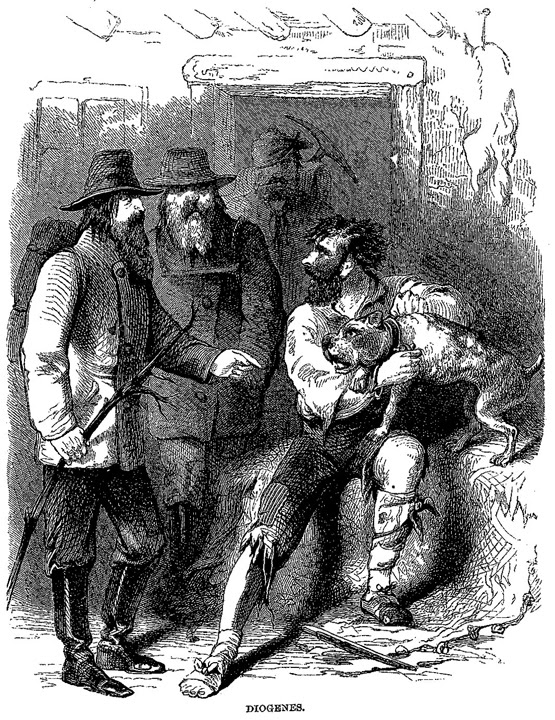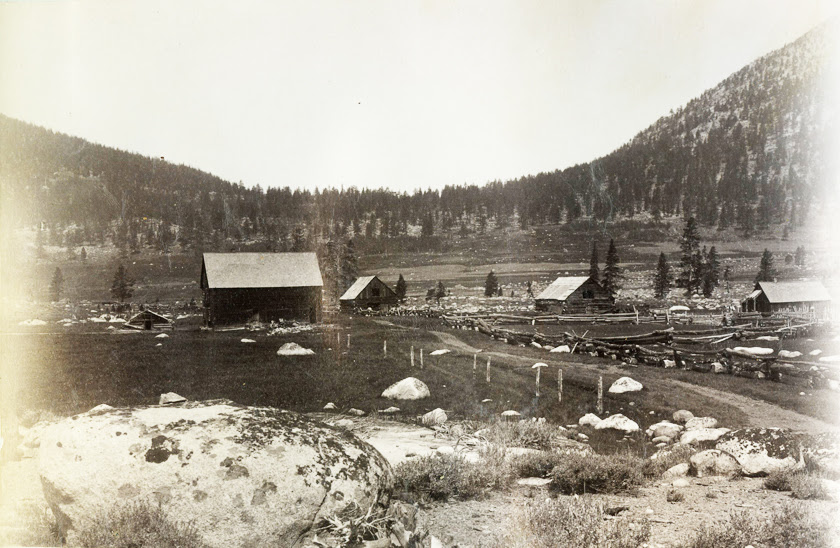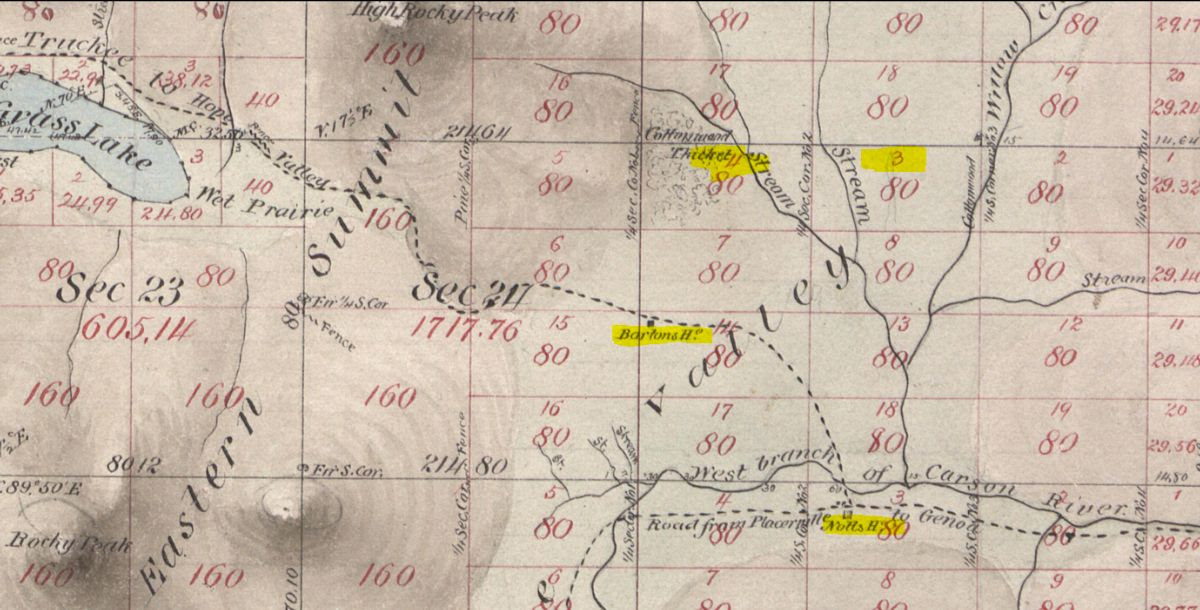You gotta love the excitement of unraveling a 160-year-old mystery!
Here’s how it all began: In late 1860, journalist J. Ross Browne shared his silver-boom travels in a series called “A Peep at Washoe.” But it wasn’t just the Comstock he visited; Browne also journeyed through Alpine’s famous Hope Valley.
Hope Valley wasn’t actually part of Alpine County at the time, of course; that wouldn’t come about for another four years. And, as you can well imagine, in 1860 the valley was sparsely populated. Browne nevertheless mentioned stopping at the cabin of a curmudgeonly Hope Valley pioneer eking out a solitary existence in the company of his ferocious bulldog.
Browne never shared the name of the fellow, dubbing him only “Diogenes” – after the equally curmudgeonly Greek philosopher. But his telling was accompanied by this sketch of this early Hope Valley resident that paints a humorous image of the gent’s prickly personality.

Hence the beginning of the mystery: who was Hope Valley’s early “Diogenes”? Well, that’s remained an unsolved puzzle – until my tireless researcher-friend Debbe Nye got involved.
Browne had sprinkled a few clues into his 1860 story. He added a few more clues in 1865, when he published a second set of tales called “Washoe Revisited.” From both of those we know that Diogenes’ cabin was found “near the middle of [Hope] valley.” And it’s obvious the reclusive fellow didn’t exactly welcome visitors – at least until a bottle of whiskey was procured and passed around.
“Diogenes,” it seems, hadn’t cared much for Browne’s humorous drawing, either; he considered it a “villainous likeness” to be “wiped out by blood.” (Though that last may have been a bit of Twain-like hyperbole.)
Still, the true name of the curmudgeon himself wasn’t revealed. Until. . . the year after Browne’s 1865 visit, when a second writer paid another visit to Hope Valley. This time the occasion involved a fishing trip – yes, Hope Valley was already famous for its fine fishing in 1866!

The summer 1866 angling visit was recorded in a four-part series in the Sacramento Daily Union. The writer had adopted the pseudonym “Winkle,” but in reality the series was penned by Henry Clay Watson, an editor with the newspaper (who would, sadly enough, pass away just a year later).
“Winkle’s” report on Hope Valley identifies “the only accommodation in the valley” as that of Jim Brown, “a pioneer” who had “fenced in a quarter section” (about 160 acres). So, violà! Jim Brown must be our Diogenes, right? Well, just one small problem. Nobody by the name of Jim Brown showed up in the pertinent 1860 census.
Luckily, “Winkle” wasn’t the only fisherman to be hanging out in Hope Valley in July of 1866. A second newspaper series written by someone calling himself “Podgers” added a wealth of further details. Like J. Ross Browne, Podgers describes the Hope Valley curmudgeon near the river as a reluctant host, despite now having a “neat and commodious house” near his original log cabin. “Mighty sorry, gentleman, that I can’t accommodate you,” the man reportedly told the Podgers’ party. “[T]he old woman is off her feet, and there ain’t a soul in the house to cook a meal of vittles, and there ain’t any vittles to cook, neither.”
But, like Winkle, Podgers happily discovered that a bottle of whiskey would quickly sweeten the man’s temper. Upon being pressed, the grumpy homeowner would eventually offer a few provisions if visitors wanted to cook themselves, and allow them to sleep in his house.
Best of all, Podgers finally identifies this Hope Valley pioneer by his real name: Jim Green. (Winkle’s earlier account, it seems, had substituted “Brown” as a humorous twist.) That puts “Diogenes’” early cabin near today’s Pickett’s Junction.
Podgers also provided us with wonderful background on Jim Green himself:
In early days he roughed it all over California with his dog, rifle and blankets; lived in the mountains – seldom sleeping under a roof – hunting grizzlies and deer, and leading a wild and roving life; he finally pitched upon Hope Valley as his resting place, built a log cabin, and as he prospered, added to his domicile until he has a fine house of hewn timber, a wife and a young Jim. . . Occasionally he starts out for ‘a day’s shooting,’ and extends his excursions into the coast range, some two hundred miles distant, up the coast to the Oregon line – often making a trip of four or five hundred miles – returns and subsides until the old spirit breaks out again.
One of Winkle’s fellow fishermen would later also identify the resident as Jim Green, recalling years later (in an 1873 story in the Sacramento Daily Union) that the group had been warned that Green was “the cussedest man ever born on earth; that he was a regular snapper; had lost his front teeth, and his mouth opened and shut like a New Testament with the leaves torn out.”

This account similarly noted that Jim’s good humor could be procured through a bottle of whiskey, with visitors allowed to share a single room in Jim’s loft – “a square one with a door in each side.” Green may have been more hospitable to his own neighbors; by his own account, at least, he’d hosted a ball at his residence during the winter of 1865, with men, women and children arriving on snowshoes from Markleeville and Silver Mountain for the affair.
Green had indeed been a pioneering citizen of Hope Valley; he’d helped host a ball at Woodfords in December 1859. It’s possible he was there even earlier; someone by the same name reportedly joined Snowshoe Thompson and A.H. Hawley on their 1857 rowing expedition around Lake Tahoe. Green’s name further shows up on a petition from 1863, when he joined 30 other citizens to object to the granting of a road privilege in Carson Canyon. The following year he was summoned as a witness in an ensuing legal dispute over the road.
Green’s house in Hope Valley was such a landmark it became a reference for the new county’s boundary when Alpine County was officially formed in 1864 (referencing a point on Thompson’s Peak, two miles west of Green’s house). When the first Alpine County election was held that August, polling stations included Green’s Hotel in the “Green’s Station Precinct” (Twp 3). Not surprisingly, James Green himself served as the inspector of elections. Tax records for 1864 show Green owning 100 acres at the time, plus an assortment of cattle, horses and wagons. He also had a substantial house valued at $1,200 – confirming that his original log cabin had likely been added-onto with sawn lumber.
At the time of Winkle’s and Podgers’ visits in the summer of 1866, Jim Green would have been sharing the house with his new wife, 22-year-old Hannah J. Green (née Hennessey); they’d been married the year before, and “little Jim” was born shortly before the Podgers party arrived. The couple would eventually go on to have two more sons: Charles and George (who died as a child).
They wouldn’t remain in Hope Valley for long, however. A December 1868 deed indicates that Green sold his 1,000-acre “Green’s Ranch” in Hope Valley to S.W. Griffith, who in turn transferred the property the next day to wife Hannah Green. Perhaps that was a move intended only to deter creditors; yet another deed in May 1869 confirms the sale of an 800-acre ranch in Hope Valley by both Jim and Hannah Green to Samuel Nott.

Some say that Jim and Hannah Green moved to Markleeville in 1869; their third son was born there in June, 1869. But perhaps Jim Green’s irascible nature became too much for Hannah to bear; or maybe he went off hunting grizzlies again. However it happened, Jim Green seems to have simply disappeared that July. Hannah eventually filed for divorce in 1872 on grounds of “desertion.”
Hannah found work as a housekeeper for prominent Markleeville resident John Cronkite; she and her two surviving sons lived with Cronkite for a time, and family history suggests they remained there until Cronkite’s death in 1888. Hannah moved to Mono County, eventually passing away in Carson City in 1910.
And what finally became of the curmudgeonly James Green aka Diogenes? Even his family doesn’t know for sure. Perhaps he returned to his “wild and roving life.”
____________________
Full credit for finally identifying “Diogenes” as early Hope Valley resident James Green goes to phenomenal researcher Debbe Nye. It’s an extremely important addition to the lore of early Hope Valley, and I would respectfully ask that future writers credit her when mentioning this discovery. In addition, if other material from this story is used, kindly credit this Clairitage blog.
